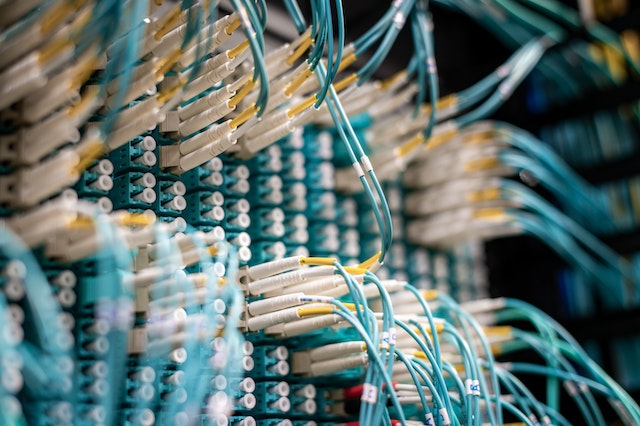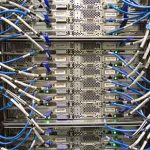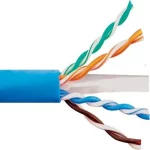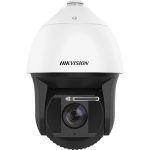- What is fiber optic cabling?
Fiber optic cabling is a type of data transmission medium that uses light pulses to transmit information. It consists of thin strands of glass or plastic fibers, which are bundled together to form a cable. Fiber optic cables are capable of transmitting data at much higher speeds and over longer distances than traditional copper cables.
- How does fiber optic cabling work?
Fiber optic cabling transmits data using light pulses. A transmitter at one end of the cable converts electrical signals into light pulses, which then travel through the fiber optic cable. At the other end, a receiver converts the light pulses back into electrical signals, which can be processed by electronic devices.
- What are the main types of fiber optic cables?
There are two primary types of fiber optic cables: single-mode and multi-mode. Single-mode fibers have a small core diameter, which allows only one light path (mode) to travel through the cable. This results in lower signal attenuation and longer transmission distances. Multi-mode fibers have a larger core diameter, allowing multiple light paths to travel through the cable simultaneously. This results in higher bandwidth but shorter transmission distances compared to single-mode fibers.
- What is the difference between fiber optic cabling and copper cabling?
The primary difference between fiber optic and copper cabling is the method of data transmission. Fiber optic cables use light pulses, while copper cables use electrical signals. This results in various advantages for fiber optic cables, including higher data transmission speeds, longer transmission distances, immunity to electromagnetic interference, and improved security.
- How is fiber optic cabling installed?
Fiber optic cabling is installed using a combination of specialized equipment and techniques. Professional installers must carefully handle and splice the delicate fibers, ensuring minimal signal loss and maintaining the integrity of the cable. Installation typically involves running the cables through conduit or raceways, attaching connectors, and connecting the cables to network equipment.
- What is the typical lifespan of fiber optic cables?
The lifespan of fiber optic cables depends on various factors, including installation quality, environmental conditions, and maintenance practices. Under ideal conditions, fiber optic cables can last for 20-25 years or more. Proper installation, regular inspection, and timely maintenance can help extend the life of your fiber optic infrastructure.
- How do you test fiber optic cables?
Fiber optic cables are tested using specialized equipment, such as optical time-domain reflectometers (OTDRs) and power meters. These instruments can measure signal loss, insertion loss, and return loss, helping identify issues such as breaks, bends, or poor connections in the cable. Regular testing and monitoring can help ensure optimal performance and minimize downtime.
- How much does fiber optic cabling cost?
The cost of fiber optic cabling depends on several factors, including cable type, installation complexity, and labor costs. While fiber optic cabling is generally more expensive upfront than copper cabling, the long-term benefits, such as higher bandwidth, longer transmission distances, and lower maintenance costs, can outweigh the initial investment.
- Can fiber optic cables be used for both indoor and outdoor applications?
Yes, fiber optic cables can be used for both indoor and outdoor applications. However, different types of cables are designed for specific environments. Indoor cables are typically more flexible and lightweight, while outdoor cables are more rugged and resistant to environmental factors such as moisture, temperature fluctuations, and UV radiation.
- Can I upgrade my existing copper network to fiber optic cabling?
Yes, you can upgrade your existing copper network to fiber optic cabling. The process typically involves replacing your existing copper cables with fiber optic cables and installing the necessary network equipment, such as fiber optic switches and media converters. Upgrading to fiber optic cabling can provide significant benefits, including increased bandwidth, improved reliability, and enhanced security. However, the cost and complexity of the upgrade will depend on factors such as the size of your network, the existing infrastructure, and the specific requirements of your organization.
- Is fiber optic cabling suitable for residential applications?
Yes, fiber optic cabling is suitable for residential applications. Many internet service providers (ISPs) now offer fiber-to-the-home (FTTH) connections, which provide high-speed internet access directly to residences using fiber optic cables. These connections can deliver gigabit-speed internet, enabling faster downloads, smoother streaming, and improved performance for multiple connected devices.
- What are the common connectors used with fiber optic cables?
There are several types of connectors used with fiber optic cables, including:
- SC (Subscriber Connector): A push-pull connector commonly used in datacom and telecom applications.
- LC (Lucent Connector): A small form-factor connector similar to the SC connector, often used in high-density applications.
- FC (Ferrule Connector): A threaded connector primarily used in single-mode applications and high-vibration environments.
- ST (Straight Tip): A bayonet-style connector widely used in multimode applications.
- MTP/MPO (Multi-fiber Termination Push-On/Multi-fiber Push-On): A high-density connector used with ribbon or array cables, supporting multiple fibers in a single connector.
- How do I choose the right fiber optic cable for my application?
Choosing the right fiber optic cable for your application depends on several factors, including:
- Transmission distance: Single-mode fibers are better suited for long-range applications, while multi-mode fibers are typically used for shorter distances.
- Bandwidth requirements: Consider the amount of data your network needs to handle and choose a cable that can support your bandwidth requirements.
- Environmental conditions: Select a cable designed for the specific conditions of your installation, whether it’s indoor, outdoor, or in a harsh industrial environment.
- Connector compatibility: Ensure the cable you choose is compatible with the connectors and network equipment in your system.
Consulting with a fiber optic cabling expert or professional installer can help you determine the best solution for your specific needs.
Fiber optic cabling offers numerous advantages over traditional copper cabling, making it an ideal solution for a wide range of applications across various industries. By understanding the basics of fiber optic technology and addressing common questions, you can make informed decisions about incorporating fiber optics into your network infrastructure. Whether you’re upgrading an existing network or designing a new one, fiber optic cabling can provide the speed, reliability, and performance needed to support modern communication requirements.





